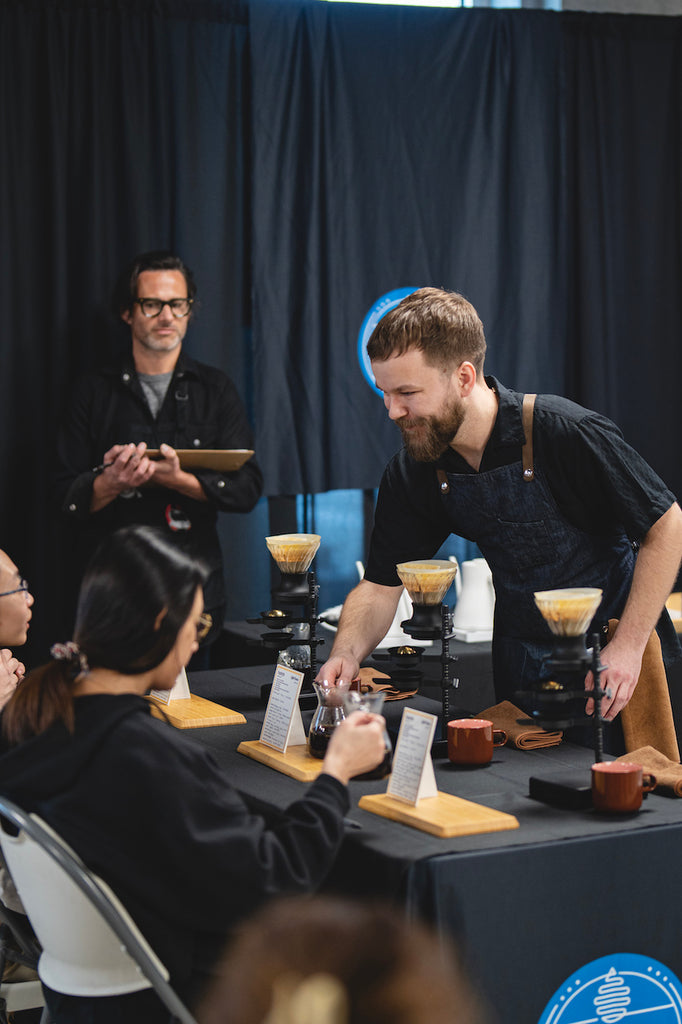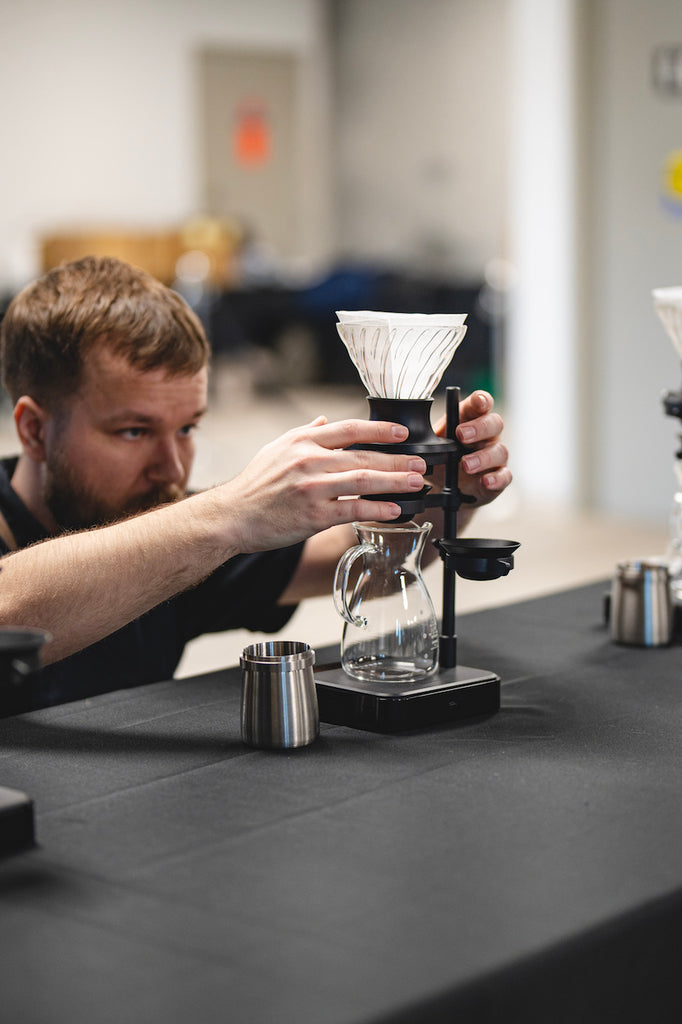Interview with AJ Doell - Third Place Winner of Canadian National Brewers Cup 2024

AJ Doell, our Inventory Manager & Product Specialist, recently placed 3rd place at the Canadian National Brewers Cup'24!
For those unfamiliar with the CNBr, it's a competition where participants can choose any set of manual brewing devices to brew and serve coffee to a panel of judges across two distinct services: a compulsory one and an “open” service.
In each service, competitors must present 3 individual but uniform brews of the same coffee to the judges. In the compulsory service, competitors must prepare their beverages from a provided and undisclosed coffee.
Conversely, in the open service, participants have the freedom to select any coffee of their choice and accompany it with a personalized presentation.
This year marked AJ’s third participation in the competition, highlighting his ongoing commitment to excellence. In celebration of this achievement, we sought insights from AJ regarding his experiences as a competitor and his process of selecting competition coffee and developing a recipe.

Q. Tell us more about your coffee journey.
It started when I moved to Sydney, Australia in 2014.
A family member of mine told me to give coffee in Australia a chance, and said it was very different from what I grew up drinking. I slowly went from drinking sweet mochas to flat whites with honey, and then into the cold drip and pour-over world halfway through 2015.
At that point, I was a regular at my local cafe, and started to order “whatever is best on bar today”, and my barista pulled out a small sample bag and shared a pour-over with me.
That washed Geisha from Guatemala was not only my first ‘ah-ha’ moment in coffee, it was the catalyst that pushed me into the ‘rabbit hole’ that I’m still adventuring into this day.
Q. What coffee did you compete with and how did the coffee selection work for you?
I used a GORGEOUS washed Geisha from Diego Bermudez from El Paraiso in Colombia (roasted by the one and only Boris at Hatch in Markham, Ontario) called SAKE.
Even though I have a strong affinity for Deigo’s coffee, Boris often provides 5-8 sample bags with no labels (other than a special number combination to distinguish each coffee). I love this process because it forces me to not have any bias towards any farm name, style of process, or even region! I have found this process extremely helpful and I cannot recommend it enough to anyone hoping to compete.
Q. Why did you use two different temperatures for your bloom and your pours?
I find that using multiple kettle temperatures can not only give more control over my extraction but also change how each phase of brewing extracts.
To use an analogy, in baseball, the players sometimes slide into their base, which not only gives them more control to finish their run but also naturally slows them down. For my final pour, I used a lighter temperature to ‘slide into home base’ and slow down my extraction near the end of my brewing.
Q. Why did you go for a hybrid brewer (pour-over/immersion)?
Both the sweetness and texture from Deigo’s SAKE were outstanding when we first experienced it on the cupping table, and I wanted to amplify this through my brewer.
The Hario Switch worked perfectly because I could use the Nucleus Paragon to capture my first portion of the brew, but leave the switch closed at the end (to mimic the immersion process on the cupping table).
This allowed me to amplify and showcase both the sweetness and texture but also slowed down the extraction process since the solution (i.e. the brewing water) would become more concentrated near the end.
Q. Why did you use Paragon?
I have been consistently using the Paragon by Nucleus over the last year since CNBrC 2023, and I truly believe in the product and what it’s designed to do.
Every coffee that I have brewed with it has improved it’s aromatic qualities, and all you need to do is discover how much of your initial brew should be ‘paragon-ed’.
I also believe the aromatic experience plays a huge part in the overall sensory experience. We often smell the coffee well before we consume it, and since this will be our first impression of the coffee, I want that experience to be memorable in the best way possible.
Q. How about your compulsory service? How did you approach it? Did you have a preset recipe?
Compulsory is such a hard thing to prepare for, and often you need to just trust your gut instinct when you are in the moment. However, I think you should have a strong gameplan that allows you to experience a wide range and style of extraction, and know how you should adjust from there.
In preparing for compulsory, I developed a single recipe that I could use in all three brewers but changed one variable quite significantly (and by doing so allowed me to taste a wide range of the coffee’s extraction journey).
After selecting which cup out of the three I enjoyed, I then actioned a planned second round of brewing. In this phase, I made light adjustments from my first round (while keeping my favourite cup off to the side).
After this second round of brewing, I then had 3-4 brews all beside each other, that had slightly different adjustments done to them. Then you just need to trust your gut and start preparing for compulsory service.
Q. How do you choose a theme and build a routine for your open service?
Choosing your theme for your routine is not an easy thing, especially when you are trying to balance adding coffee knowledge and technical knowledge on top of personal connection.
I often have a theme idea early on, but it’s more of a framework around how I want the set to begin and end (keeping it more conceptual). Doing this allows me to adjust more on the fly, and also mold my routine to fit with my coffee and producer.
You can always give massive amounts of technical or coffee knowledge, which is still great and very important for pushing the coffee community forward, but I often find the first final sentence from a routine will resonate with me the most.
Q. Is there anyone you would like to thank?
First, I would like to thank Eight Ounce! Even though my role as an inventory manager doesn’t directly connect to the competition space, they still support my passion for the competition space and have been my primary sponsor since the beginning.
Without the Hatch team, my competition journey would not be what it is. Their head roaster, Boris, immediately helped me last year when I didn’t have a coffee 3 weeks away from the competition, and has been amazing to work with ever since.
My competition journey started back in 2020 when I had a Diego coffee (El Paraiso Peach…if you know, you know), and it’s been an honour to showcase their amazing work and talent on the National stage for the last 2 years. Thank you to Boris, Alfonso, Josh, Benny, Jenny, Kelvin and the entire team for supporting me, and I will always be a #hatchling4lyfe
I also would like to thank Jerome and the Nucleus team for supporting me for the last two years. They not only sponsored my Paragon setup, but Jerome was immediately willing to share heaps of knowledge about the Paragon. This openness and willingness to share knowledge is inspiring and pushes me to do the same when I interact with other competitors.
And without the support of my coach, Geraldine, my finals placement would have not been possible.
She helped me stay level-headed when the pressure was high and was a sound mind to bounce crazy ideas off of. When I was practicing, she pointed out even the smallest things that I could improve on, and this helped me elevate my score massively. And when you are competing in a very strong field like Brewers Cup, the littlest things can lead to a huge difference in your final placement.
Q. How do you handle disappointment or perceived failure, especially in a competitive environment? Can you share your approach and any insights for those considering competing but feeling apprehensive?
*Triggered* *laughing/sweat emoji* In 2023 (my second year of competing), I didn’t fully serve my compulsory coffee. By serving it less than 10ml away from the required minimum, it disqualified my score, not allowing me to proceed into the top 6 for that year.
The event felt like I had a cut inside my chest, and it almost took me out of competing this year. It takes so much time, energy, commitment, and care to develop your routine for both open and compulsory each year, and in 1 second a wrong decision can unravel everything. And then when you add the additional commitment and support from your roaster, coach, sponsors, and even family, it can be devastating and hurt for a long time.
But if you are aiming to never have a failure, especially in a competition setting, it’s nearly impossible to have that happen if you compete long enough.
Even though it hurts to fall or fail, the joy and personal growth I have experienced from competing far outweighs the negatives. And when you inevitably land on your face, I have found doing it around other competitors and this community is the best place to fail.
Everyone who competes knows what it takes to prepare for an event like this, and can relate/commiserate on a much deeper level when we miss our mark. But this shared experience (both the highs and the lows) along with our collective passion for growing and pushing specialty coffee forward makes this community extremely special, and I am wildly grateful to be a part of it.
Q. Anything else you would like to add?
It’s been a crazy 3 years of competing, and every year I come back, everyone collectively raises the bar even higher.
I am proud that I could share the top 6 stage with some extremely talented brewers this year like Evgeniia, Cleo, and Josh! To Ply, you are an extremely talented brewer and an even better person, and it was an honour to compete alongside you.
And to our champion and fellow ‘hatchling’, Kunie, you did an incredible job this year moulding your customer service, technical, and coffee knowledge into a beautiful routine supported by an incredible brew. You are an outstanding competitor, and I can’t wait to see you kill it on the world stage in Chicago!
Q. Do you mind sharing your recipe (open service)?
Absolutely! I tailor each recipe to work best with my coffee, but I will keep this one in my ‘back pocket’ if I want to push the texture and sweetness of a brew.
Grind: Decent bit above filter coffee (fine French Press size) (PIETRO 8.0)
Dose: 20g
Ratio: 1:14 (20:280)
Filter Paper: Sibarist B3 Hybrid Papers
Water: LOTUS Water - 30 ppm Mg, 20ppm Cl, 15-20ppm K
Temp: 92c for blooms, 88 for immersion
Bloom the coffee twice over the Paragon (two pours of 60g for 45 seconds, totalling 120g [0:00-1:30]) with the switch remaining open
At 1:30, close the switch and add the remaining portion of your water within 15 seconds (from 120g to 280g).
Steep until 3:00, then open the switch to draw down.
End of the drawdown should be around 3:30! Stir the coffee, first smell, and then enjoy!
Photos courtesy of @andychanmedia







